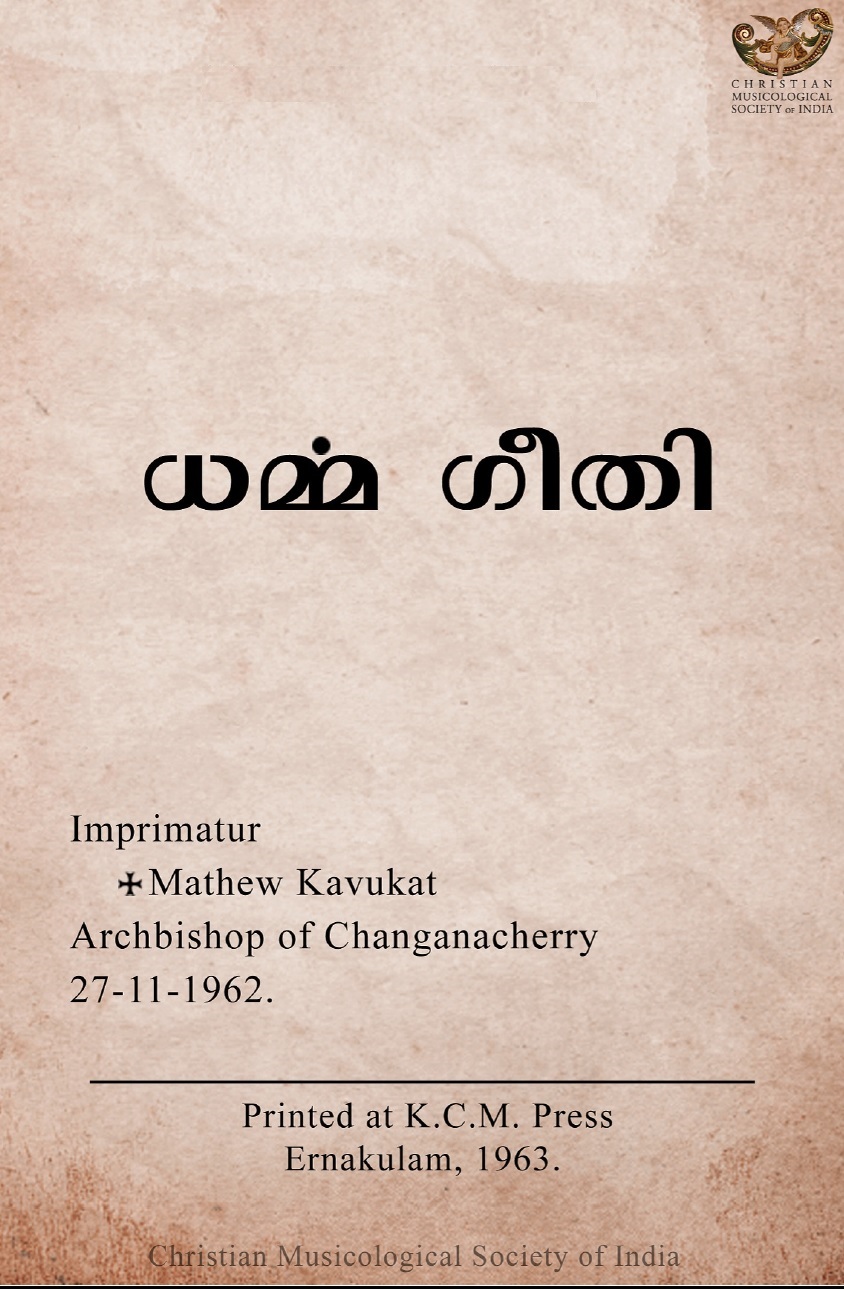Music Resource Code : MA-MAL-017
Dhaṛma gīti
ധർമ്മ ഗീതി
(Dharmageethi, Hymnals in Malayalam)
Compiled by
The Staff and Students
Dharmaram College, Bangalore
A Review by
Joseph J. Palackal CMI, (2017)

- Printed at K. C. M. Press, Ernakulam, (Commercial Movies & Christian Worship in Kerala: A Musical Intersection)
- Year- 1963
The hymnal was intended for private use at Dharmaram College, the Seminary of the religious congregation of the Carmelites of Mary Immaculate that the saintly Palackal Thoma Malpan (1780-1841; my collateral ancestor),PorukaraThomaMalpan (1799-1846), and Saint Kuriakose Elias Chavara (1805-1871) founded in 1831 in Kerala. The title of the hymnal takes after the Sanskrit name of the seminary, Dharmārām, which literally means “garden of virtues.” In the 1960s, over two hundred seminarians lived and studied at one point in time at Dharmārām, The hymnal was in use until the 1970s.
There are 133 songs of which 130 are in Malayalam and the other three are Syriac chants printed in Malayalam script. The songs are grouped under 12 headings:
- Hymns in praise of Jesus: songs 1-38
- Hymns in praise of Blessed Virgin Mary: 39-65
- Christmas songs: 66-74
- To the Holy Spirit: 75-79
- To St. Joseph: 80-86
- St. Thomas the Apostle: 87-93
- St. Theresa of Avila: 94-100
- St. John of the Cross: 101-105
- St. Theresa of Lisieux: 106-110
- The patron saints of different residence buildings of the Seminary
- Songs for various occasions:
- Syriac chants for the Benediction: 117-118
- Litanies: 120-124 - Stations of the Cross 125
- Hymns to the Holy Spirit: 126-128
- Stations of the Cross 125
- Hymns to the Holy Spirit: 126-128
- The Lord’s Prayer: 129
- Hail Mary: 130
- Hymn to Mary: 131
- Dedication to the Holy Spirit
12. Malayalam translation of the Latin chant Te Deum: 133
The tune is indicated in parenthesis below the title by the opening words of the film song to which the lyrics are written;in some cases, the name of the film in which the song appears is also mentioned. The number of stanzas and the number of verses in each stanza coincide with those of the film song. These songs were not part of the official liturgy of the Syro Malabar Church, they were sung during such paraliturgical services as the Holy Hour (adoration of the Blessed Sacrament), Benediction, prayer gatherings, litanies and novenas to saints.
The hymnal lacks an Introduction. Hence, we have no information on the thought process that went into its preparation and publication.What is conspicuous by its absence are the names of the lyricists. It is possible that a few of those hymns were written by the talented students at the seminary. Some of the hymns were popular among Catholics all over Kerala.
The preparation of the hymnal took place during the time when the Syro Malabar Church was engaged in translating the liturgy from Syriac to Malayalam. The inauguration of the Malayalam version took place on July 3, 1962, one year before the publication of this hymnal. The inclusion of the Syriac chants shows the continuity and comfort level of the worshippers with the Syriac language and chants. Two of the three Syriac chants (117 &118) are translations of the Latin chant Pange Lingua by St. Thomas Aquinas (1225-1244). The third one (65), šlām lēk (“shanti to you [Mary]”) is a chant in honor of the Blessed Virgin Mary. The community used to end the night prayers with a hymn to the Blessed Virgin. This Syriac chant was sung on that occasion..
Interestingly, there is only one instance of using a melody from a Tamil film (38); Tamil is the language of the neighboring state of Tamil Nadu. Yet, the Christians in Kerala were more tuned to the film songs in Hindi, the language of the distant north. One reason may be that All India Radio. stations in Kerala gave greater importance to Hindi songs than Tamil songs, and cinema theaters in Kerala screened comparatively more films in Hindi than Tamil .
This hymnal is a case in point for an uncanny musical interface of commercial movies and Christian worship in Kerala. The Catholics were quite comfortable in celebrating their faith by singing secular melodies with their visual connotations. The hymnal also portrays the poetic imagination of a particular period in the history of Christian lyricists in Kerala, and bears a testimony to the theological thinking and prayer vocabulary of the time. Finally, this hymnal documents the names of a number of popular songs and the names of films in which they appear, indicating cross cultural communication within the country.
Joseph J. Palackal
New York
1 November 2016
Songs added to Directory of Christian Songs (DCS)
| # | DCS Call Numbers | Page Links |
| 1. | DCS-086 to 100 | |
| 2. | DCS-100 to 219 |
Keywords : Dharmagiti, Dharmageethi, Dharmagithi,Dharmageeti, Dr. Joseph J. Palackal CMI, Dharmaram College Bangalore, Christian Music in Malayalam, Carmelites of Mary Immaculate, CMI, Hymns in Praise of Jesus, Hymns in praise of Blessed Virgin Mary, Hymns to the Holy Spirit, Hymns to Saint Joseph, Hymns to St. Thomas the Apostle, Syriac Chants for Benediction, Stations of the way of the Cross



